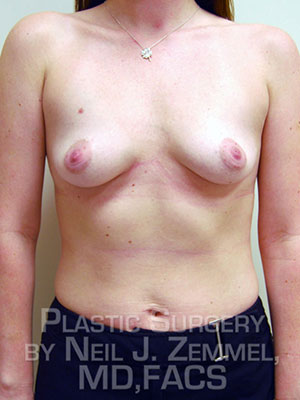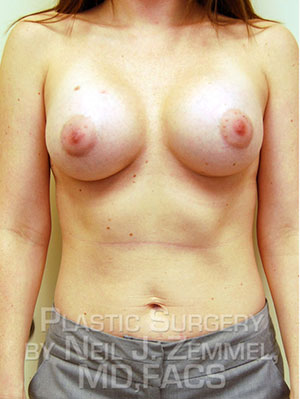Surgical Techniques
Since each woman’s body is different and each patient has different aesthetic goals, the ideal surgical technique for breast augmentation surgery will vary from person to person. However, the goal of each approach is the same: to create a stable soft tissue pocket beneath the breast tissue and pectoralis muscle that will hold the implant naturally on the chest wall. Dr. Neil Zemmel uses his extensive experience in breast augmentation to minimize associated risks while forming a pocket that is neither too wide (which can cause unwanted movement of the implant) nor too narrow (which can cause tightness around the implant and a distorted implant shape). The approach to your breast augmentation and implant placement can be custom-tailored to meet your unique needs.
- Incision Locations: Inframammary, Periareolar, and Transaxillary
- Pocket Location and Type: Submuscular, Subglandular, and Dual Plane
- No Touch Implant Placement
Incision Locations: Inframammary, Periareolar, and Transaxillary
The decision regarding the surgical approach used for your breast augmentation is just as important as choosing a properly fitting implant. With three major incision locations to choose from, Dr. Zemmel takes time with each of his patients at Richmond Aesthetic Surgery to determine which approach can best produce beautiful results with the fastest recovery period.
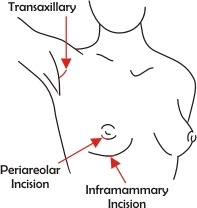 For patients undergoing a breast lift (or mastopexy) along with a breast augmentation, our surgeon can use the same incision to optimize the aesthetic outcome of the surgery.
For patients undergoing a breast lift (or mastopexy) along with a breast augmentation, our surgeon can use the same incision to optimize the aesthetic outcome of the surgery.
- Periareolar: A periareolar incision is made along the edge of the areola and the skin of the breast, allowing the incision to be hidden once it heals. For some patients, this incision is nearly invisible only a few months after surgery. The location of a periareolar incision – the center of the breast – gives the plastic surgeon an ideal angle to view and create the soft tissue pocket needed to receive an implant. By using the periareolar incision, our surgeon will have a 360-degree view of the pocket. This is similar to looking through the top of a dome. A periareolar incision is also ideal for patients who wish to undergo simultaneous breast lift surgery, as no additional incision is required. In addition, should a patient require breast revision surgery in the future, the periareolar approach allows a surgeon to conduct a revision procedure without creating an entirely new incision.Loss of nipple sensation is often a major concern of our breast augmentation patients, and many patients are concerned that an incision along the areola will increase this risk. However, studies have shown that the rates of nipple sensation disturbance do not correlate to the incision type. In fact, the nerve that causes nipple and areolar sensation is located beneath the nipple itself – not along the edge of the areola where a periareolar incision is made. While loss of nipple sensation still remains a risk associated with breast augmentation, a periareolar incision does not increase this risk.
- Inframammary: An inframammary incision is made beneath the breast, along the crease where the breast meets the chest. This traditional approach to breast augmentation also allows the plastic surgeon a good view when creating the soft tissue pocket. However, an inframammary incision may be slightly more visible after the recovery period, especially when wearing clothing such as a bikini top. For women who have a smaller areola diameter and are not eligible for a periareolar incision, an inframammary incision may offer an effective alternative for achieving breast augmentation results that look and feel natural.
- Transaxillary: A transaxillary incision is made in the underarm area, and though a soft tissue pocket may still be created using this approach, the risk of implant malposition increases. Patients who opt for a transaxillary incision and wish to simultaneously undergo a breast lift will also require a second incision to accomplish their goals. In addition to preventing the plastic surgeon from performing a dual plane breast augmentation, the transaxillary approach also has the highest chance of leaving more visible scarring after surgery.
Pocket Location and Type: Submuscular, Subglandular, and Dual Plane
Along with your breast implant selection and your incision choice, you and your board-certified plastic surgeon will also discuss which pocket location and type can best achieve your cosmetic goals. Silicone and saline implants are placed beneath the breast tissue and can either be placed above or below the pectoralis muscle.
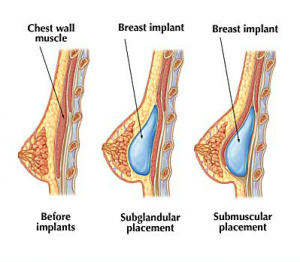
- Submuscular: A submuscular approach is a newer breast augmentation technique that places the implant beneath both the breast tissue and the pectoralis muscle. During this procedure, the breast pocket is created on the rib cage as opposed to on top of the pectoralis muscle. In nearly all cases, Dr. Zemmel often recommends the submuscular approach to his patients since the risks associated with breast augmentation are minimized and the results tend to look and feel more natural. Because the implant resides beneath the muscle with a submuscular approach, there is more natural tissue covering the implant. This extra tissue can help an implant feel more like a natural breast. By burying the implant under more tissue, the implant is more effectively camouflaged. In addition, a submuscular approach can reduce the risk of implant malposition and capsular contracture – two common concerns among breast augmentation patients.
- Subglandular: A subglandular approach is a more traditional breast augmentation technique that places the implant beneath the breast tissue but above the pectoralis muscle. Though this placement approach can cause the implant to look and feel a bit less natural, the recovery period can be easier using a subglandular approach. In addition, the subglandular approach can make the lower portion of the breast appear fuller and more round after the procedure. However, patients should be aware that the subglandular approach can also increase the risk of post-operative rippling and capsular contracture. Because of these risks, Dr. Zemmel performs subglandular breast augmentation only in very select cases.
- Dual Plane: A “dual plane” approach is an innovative means of implant placement that uses a combination of the submuscular approach and the subglandular approach to reap the respective benefits of each while mitigating the risks. By placing the implant partially beneath the pectoralis muscle, the upper portion of the implant is covered by your body’s natural tissue, which can provide a more realistic feel. Since the lower portion of the implant is beneath the breast tissue but above the pectoralis muscle, you will still have a rounder, fuller shape to the lower breast.The dual plane approach can be used for implant placement using either a periareolar or inframammary incision, and is Dr. Zemmel’s preferred breast augmentation method for women who have slight sagging to the breast. Using this approach, he can maximize the outcome of the surgery while minimizing the risk of rippling and capsular contracture. In addition to a more natural feel, the dual plane approach to implant placement produces a teardrop shape that closely mimics the appearance of a natural breast.
To help you navigate the decision of which pocket location and type is best for your individual needs, Dr. Zemmel spends time during the breast augmentation consultation process to ensure you have a mutual understanding of your surgical expectations. After this conversation, your surgeon can assist you in choosing the breast implant placement technique that can most effectively achieve your needs and goals.
No Touch Implant Placement
The “no touch” approach is quickly becoming the preferred method of implant placement among because of the clear benefits for the patient. The main concept behind no touch implant placement is to prevent any contact between the implant and the patient’s skin during breast augmentation. When this contact is prevented while placing the implant in the breast pocket, the risks of bacterial infection and capsular contracture are significantly reduced.
Keller Funnel
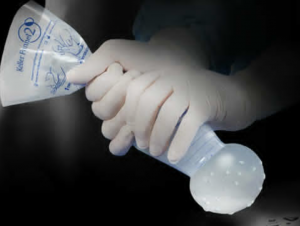 The Keller Funnel is a state-of-the-art surgical tool used by plastic surgeons to make implant placement both safer and more efficient. This is the device that allows Dr. Zemmel to insert saline or silicone implants into the breast pocket using “no touch” placement. In addition to the benefits that go along with preventing the skin from contacting the implant, the Keller Funnel actually allows Dr. Zemmel to perform breast augmentation surgery more efficiently so his patients spend less time in the operating room. The Keller Funnel is also an extremely delicate method of implant placement, so the procedure requires a smaller incision and causes less trauma to the shell of the implant compared to other placement techniques. Since a smaller incision is needed when using the Keller Funnel, the procedure can also minimize the visibility of scars after the healing process is complete.
The Keller Funnel is a state-of-the-art surgical tool used by plastic surgeons to make implant placement both safer and more efficient. This is the device that allows Dr. Zemmel to insert saline or silicone implants into the breast pocket using “no touch” placement. In addition to the benefits that go along with preventing the skin from contacting the implant, the Keller Funnel actually allows Dr. Zemmel to perform breast augmentation surgery more efficiently so his patients spend less time in the operating room. The Keller Funnel is also an extremely delicate method of implant placement, so the procedure requires a smaller incision and causes less trauma to the shell of the implant compared to other placement techniques. Since a smaller incision is needed when using the Keller Funnel, the procedure can also minimize the visibility of scars after the healing process is complete.
Throughout the consultation process and the weeks leading up to your breast augmentation, Dr. Zemmel seeks to achieve your cosmetic goals and give you accurate and realistic expectations for your procedure. Since there are so many choices to be made in regard to breast implant options and breast surgery techniques, our board-certified plastic surgeon strives to ensure that each of his patients is able to make well-educated decisions about her health and feels comfortable with her choices before going into surgery. If you would like to learn more about breast augmentation surgery, or if you would like to schedule a consultation, please contact us today.
